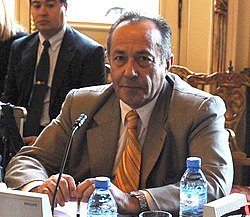Adolfo Rodríguez Saá
| Adolfo Rodríguez Saá | |
|---|---|
 |
|
| 49th President of Argentina | |
|
In office December 23, 2001 – December 30, 2001 |
|
| Vice President | Vacant |
| Preceded by | Fernando de la Rúa |
| Succeeded by | Eduardo Duhalde |
| National Senator of Argentina | |
|
Assumed office December 10, 2005 |
|
| Constituency | San Luis |
| National Deputy of Argentina | |
|
In office December 10, 2003 – December 9, 2005 |
|
| Constituency | San Luis |
| Governor of San Luis | |
|
In office December 10, 1983 – December 22, 2001 |
|
| Vice Governor | Alicia Lemme |
| Preceded by | Hugo di Rissio (de facto) |
| Succeeded by | Alicia Lemme |
| Personal details | |
| Born |
July 25, 1947 San Luis |
| Nationality | Argentine |
| Political party | Justicialist |
| Spouse(s) | María Alicia Mazzarino |
| Profession | Lawyer |
| Signature |  |
Adolfo Rodríguez Saá (born July 25, 1947) is an Argentine Peronist politician. Born in a family that was highly influential in the history of the San Luis Province, he became governor in 1983, after the end of the National Reorganization Process military dictatorship. He remained governor up to 2001, being re-elected in successive elections.
President Fernando de la Rúa resigned in that year, amid the December 2001 riots, and the Congress appointed Rodríguez Saá as president of Argentina. In response to the 1998–2002 Argentine great depression, he declared the highest sovereign default in history and resigned days later amid civil unrest. The Congress appointed a new president, Eduardo Duhalde, who completed the term of office of De la Rúa. Rodríguez Saá ran for the 2003 and 2015 presidential elections but did not win.
Rodríguez Saá was born to an important political family in San Luis. The Rodriguez Saá family is well known in the Province of San Luis and can be traced to the 19th century and to descendants of the federal caudillo Juan Saá, who fought in the battle of Pavón during the Argentine Civil War. Rodríguez Saá's grandfather and namesake Adolfo Rodríguez Saá and his great-uncle were both governors of the province, and his father was the police chief.
He attended the "Juan Pascual Pringles" school, which was associated with the National University of Cuyo. He studied law at the University of Buenos Aires, graduating in 1971. He worked as a teacher in his former school for two years. He was an editor of the anti-Peronist pamphlet "La voz de San Luis" (Spanish: The voice of San Luis), but became a Peronist in 1969 during his studies in Buenos Aires. He joined the Peronist Youth in the year of his graduation and worked as their representative in San Luis.
...
Wikipedia
